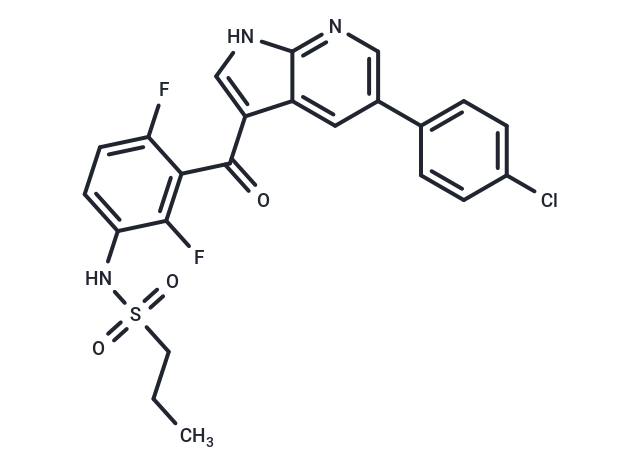购物车
- 全部删除
 您的购物车当前为空
您的购物车当前为空

Vemurafenib (RG7204) 是一种 B-RAF 抑制剂,可以抑制 RAFV600E 和 c-RAF-1 (IC50=31/48 nM),具有选择性和有效性。Vemurafenib 具有抗肿瘤活性,用于 BRAF V600E 突变阳性的黑色素瘤治疗。

Vemurafenib (RG7204) 是一种 B-RAF 抑制剂,可以抑制 RAFV600E 和 c-RAF-1 (IC50=31/48 nM),具有选择性和有效性。Vemurafenib 具有抗肿瘤活性,用于 BRAF V600E 突变阳性的黑色素瘤治疗。
| 规格 | 价格 | 库存 | 数量 |
|---|---|---|---|
| 5 mg | ¥ 262 | 现货 | |
| 10 mg | ¥ 430 | 现货 | |
| 25 mg | ¥ 690 | 现货 | |
| 50 mg | ¥ 970 | 现货 | |
| 100 mg | ¥ 1,491 | 现货 | |
| 500 mg | ¥ 3,868 | 现货 | |
| 1 mL x 10 mM (in DMSO) | ¥ 474 | 现货 |
| 产品描述 | Vemurafenib (RG7204) is a B-RAF inhibitor that inhibits RAFV600E and c-RAF-1 (IC50=31/48 nM) selectively and potently. Vemurafenib exhibits antitumor activity and is used for the treatment of BRAF V600E mutation-positive melanoma. |
| 靶点活性 | B-Raf (V600E):31 nM (cell free), Ack1:19 nM (cell free), SRMS:18 nM (cell free), C-Raf1:48 nM (cell free) |
| 体外活性 | 方法:黑色素瘤细胞 A375 和 SK-Mel-28 用 Vemurafenib (0-8 μM) 处理 48 h,使用 CCK-8 assay 检测细胞活力。 结果:Vemurafenib 剂量依赖性抑制 A375 和 SK-Mel-28 细胞增殖,IC50 分别为 0.8 μM 和 1.8 μM。[1] 方法:表达 BRAF V600E 的黑色素瘤细胞系 Colo829 和 LOX 用 Vemurafenib (0.05-30 μmol/L) 处理 2 h,使用 Western Blot 方法检测靶点蛋白表达水平。 结果:Vemurafenib 抑制了 Colo829 和 LOX 细胞中 MEK 和 ERK 的磷酸化。[2] |
| 体内活性 | 方法:为检测体内抗肿瘤活性,将 Vemurafenib (12.5-75 mg/kg,suspended in an aqueous vehicle containing 2% Klucel LF and adjusted to pH 4 with dilute HCl.) 口服给药给携带黑色素瘤 LOX 的 Athymic nude 小鼠,每天两次,持续 11-13 天。 结果:Vemurafenib 显著抑制肿瘤生长并诱导肿瘤消退。[2] 方法:为检测体内抗肿瘤活性,将 Vemurafenib (60 mg/kg) 口服给药给携带黑色素瘤 Colo-205 的 athymic mice 小鼠,每天两次,持续十四天。 结果:Vemurafenib 有效抑制 Colo-205 异种移植小鼠模型中的肿瘤生长。[3] |
| 激酶实验 | Expression and purification of B-RAF, structure determination, and protein kinase activity measurements were carried out as previously described. To obtain co-crystals of B-RAFV600E with PLX4032, the protein solution was initially mixed with the compound dissolved in DMSO at a final compound concentration of 1 mM. This complex was co-crystallized by a sitting drop vapor diffusion experiment in which equal volumes of complex (at 10 mg/ml concentration) and reservoir solution (100mM BisTris at pH 6.0, 12.5% 2,5-hexanediol, and 12% PEG3350) were mixed and allowed to equilibrate against the reservoir at 4°C. The crystal was soaked in cryosolvent, followed by flash-freezing in liquid nitrogen. The data were collected at Beamline ALS831 with the wavelength of 1.11?. The Ramachandran plot from the refined structure shows that 94%, 5.6% and 0.4% residues are in the most favored, additional allowed and generously allowed regions, respectively. A summary of the crystallography statistics is included in Supplementary Table 3. COLO205 tumor xenograft studies (Molecular Imaging Research, Ann Arbor, MI) were carried out as previously described either using a conventional formulation (5%DMSO, 1% methylcellulose) or using the MBP formulation [1]. |
| 细胞实验 | Cellular proliferation was evaluated by MTT assay. Briefly, cells were plated in 96-well microtiter plates at a density of 1,000 to 5,000 cells per well in a volume of 180 μL. For the assay, RG7204 was prepared at 10 times the final assay concentration in media containing 1% DMSO. Twenty-four hours after cell plating, 20 μL of the appropriate dilution were added to plates in duplicate. The plates were assayed for proliferation 6 days after the cells were plated according to the procedure originally described by Mosmann [2]. |
| 动物实验 | All animal procedures were approved by the Ethical Commission of the Institute for Cancer Research and Treatment and by the Italian Ministry of Health. WiDr cells were injected subcutaneously into the right posterior flanks of 7-week-old immunodeficient NODSCID female mice (6 mice per group). Tumour formation was monitored twice a week, and tumour volume based on caliper measurements was calculated by the modified ellipsoidal formula: tumour volume = 1/2 length × width. When tumours reached a volume of approximately 200–250 mm^3, mice were randomly assigned to treatment with vehicle or drug(s) [3]. |
| 别名 | 维罗非尼, RO5185426, RG7204, PLX4032 |
| 分子量 | 489.92 |
| 分子式 | C23H18ClF2N3O3S |
| CAS No. | 918504-65-1 |
| Smiles | C(=O)(C=1C=2C(NC1)=NC=C(C2)C3=CC=C(Cl)C=C3)C4=C(F)C(NS(CCC)(=O)=O)=CC=C4F |
| 密度 | 1.46 g/cm3 |
| 存储 | Powder: -20°C for 3 years | In solvent: -80°C for 1 year | Shipping with blue ice. | ||||||||||
| 溶解度信息 | Ethanol: < 1 mg/mL (insoluble or slightly soluble) 10% DMSO+40% PEG300+5% Tween 80+45% Saline: 9 mg/mL (18.37 mM), suspension.In vivo: Please add the solvents sequentially, clarifying the solution as much as possible before adding the next one. Dissolve by heating and/or sonication if necessary. Working solution is recommended to be prepared and used immediately. H2O: < 1 mg/mL (insoluble or slightly soluble) DMSO: 18.33 mg/mL (37.42 mM), Sonication is recommended. | ||||||||||
溶液配制表 | |||||||||||
DMSO
| |||||||||||
评论内容